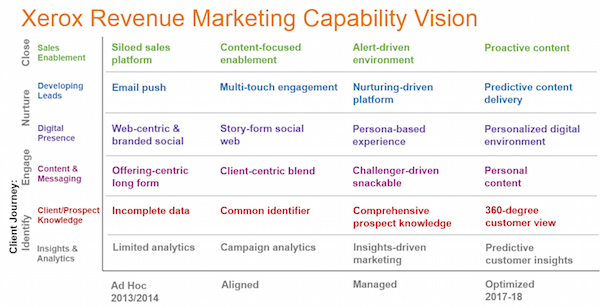While the marketing technology landscape is vibrant and crowded with innovators of all kinds, there are only a handful of companies that can legitimately take credit for having — near single-handedly — changed the very way marketers think and talk about marketing. HubSpot, the people who invented “inbound marketing,” is one of them.
So it was great to ask Mike Volpe, their CMO, a few questions about how they manage their own marketing — including the use of agile marketing principles and marketing technologist-like staff — and to get his perspective on his company’s positioning in the evolving marketing technology space.
Can you tell us a bit about your background and your passion for reinventing the discipline of marketing at HubSpot?
I’ve done online marketing since before you could buy ads on Google, back when AOL was basically the only show in town. I am very analytical (started my career in investment banking and have an MBA from MIT) and love helping make marketing about results and revenue generation, and move away from being the arts and crafts department.
But a few years ago I remember walking past my lead development team (aka cold calling) and then going to my desk and seeing my phone ring, but not recognizing the number and sending the call to voicemail. It hit me then that the buyer is now in control and we need to adapt our marketing to this new world.
“The buyer is now in control and we need to adapt our marketing to this new world.”
Since then, I have focused on making all of my own marketing more inbound and helping educate marketers on how to do more inbound marketing and have their marketing be something their potential customers will love, not find annoying.
You’re one of the pioneers of agile marketing, having been an early adopter of it with your organization. How does agile marketing work at HubSpot, particularly as you’ve grown?
Agile marketing was really helpful for us for a long time, it helped our team scale and grow without having multiple levels of organizational structure. Today we have moved on a bit — we still embrace the agile principles of moving quickly, being transparent, being agile — but we no longer stick to the rules in a strict manner. I think having followed the rules completely for over a year changed the culture of the team, and enabled us to still be agile with less of the formal process today.
Since HubSpot uses agile in its engineering organization too — right? — can you contrast some of the differences you see between agile software development and agile marketing?
It’s funny, I think we embrace the agile principles in our development too — we iterate a lot and ship often — but we don’t really do all of the agile process anymore. We have small teams that iterate a lot, ship often (multiple times a day), so we are agile (small A) but I guess we are no longer Agile (big A).
Another organizational innovation that HubSpot adopted early was the use of people with software development skills in the marketing department. I believe you call them “marketeers” — marketing + engineering. What kind of people thrive in that role?
This was a huge part of how we got started. Using technology as part of your marketing is critical, and if you can get those folks in-house, it helps you move more quickly.
It can be hard to attract and keep these folks, so sometimes you need to find these oddball hybrids of marketers and hackers who enjoy the marketing side of things but still can build software. There needs to be a reason they build marketing tools and not other types of software.
“You need to find these oddball hybrids of marketers and hackers who enjoy the marketing side of things but can still build software.”
HubSpot often gets mentioned in the category of “marketing automation” software, but you tend to resist that label. What label do you prefer and why?
Marketing automation is really v2 of email marketing — better segmentation and personalization, but it is still email. We think marketing needs to be completely transformed to be more inbound and integrated. You want to attract people, not spam them, and you want to have a complete view of your customers from website to email to social to blog, etc.
I prefer the term marketing software or all-in-one marketing software or even inbound marketing software. What is interesting is that now that we have demonstrated success with this unique strategy — we have over 8,000 customers and will do over $50m in revenue this year — many “marketing automation” companies are buying social media companies or selling to CRM companies, basically confirming our strategy and trying to copy what we do.
Marketing automation is not the right thing for customers (it’s just v2 of email marketing), so it is great to see the industry consolidating into more all-in-one marketing systems, because that is good for customers.
With a robust API and the launch of your App Marketplace, HubSpot seems to be positioning itself as more of a platform that could serve as the backbone for other marketing software applications. Is that accurate? How is that going and how do you expect it to evolve over the next couple of years?
Yes. Not only do we position ourselves that way, but I think it is actually TRUE. 🙂
As I mentioned earlier, I think marketing is going to become a first-class citizen in terms of technology in a company. The CFO has NetSuite, and VP of Sales has Salesforce.com and the CMO has… what exactly? Everyone knows the Gartner quote about the CMO spending more on technology in the near future than the CIO, and this is the reason why.
“I think marketing is going to become a first-class citizen in terms of technology in a company.”
Now, if marketing has a new system of record, you want that system to have all your other tools easily plug into it. We have both an application marketplace and a service marketplace — so all of your marketing tools you buy and services you hire can flow through your HubSpot. We were the first company in the industry to launch these, and they have been a part of our strategy for a long time. Others have since copied us, again validating the strategy.
If you could offer 30 seconds of advice to a typical CMO out there today, what would it be?
Reinvent your playbook because your customers behave differently today.
Thanks, Mike!




Silo between sales & marketing cannot be tolerated anymore! I would recommend MBWA (Management By Walking Around) and repeat what Seth Godin says: Marketing is too important to leave it to the marketing people”! Marketing does not come from the marketing department anymore it comes from the network evaluating products and services 24/7 This is the real dichotomy! Second big change: Marketers HAVE to become technologist and work VERY closely with CIO if they want to keep up with rapidly changing technologies.
I believe you are right. I can def see marketing as a first class citizen. Hubspot is one of the few that still remains relevant.